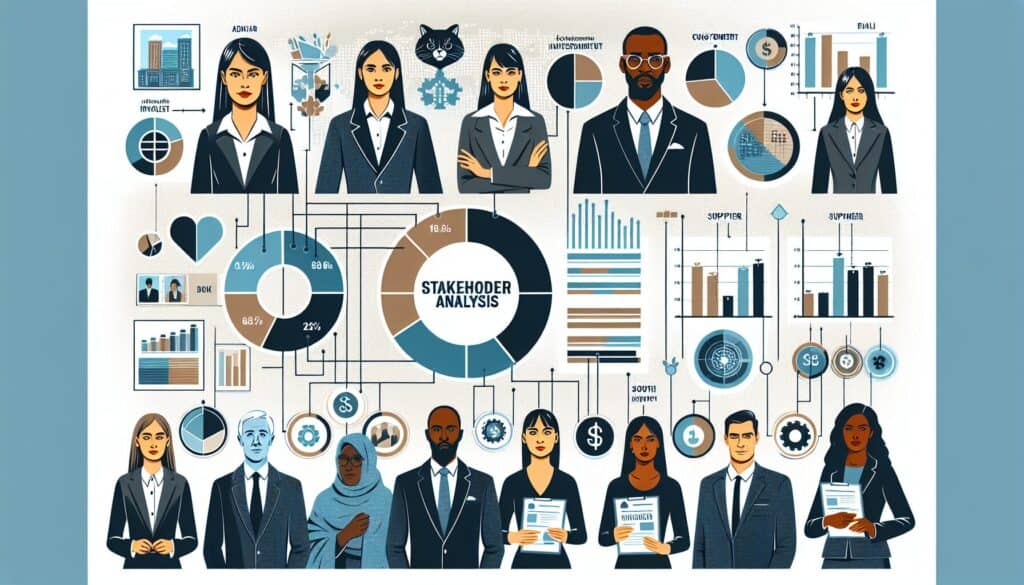To identify all individuals, groups, or organizations that can affect or be affected by a project or initiative, and to understand their interests, expectations, and influence.
- المنهجيات: الهندسة, بيئة العمل
Stakeholder Analysis

Stakeholder Analysis
- المنهجية الرشيقة, إدارة التغيير, التحسين المستمر, إدارة المشاريع, إدارة المخاطر, العمل الجماعي, تصميم يركز على المستخدم
الهدف:
كيفية استخدامه:
- Involves listing all potential stakeholders, assessing their power, interest, and potential impact on the project, and planning how to engage and manage them effectively.
الايجابيات
- Helps ensure all relevant parties are considered; Improves communication and engagement strategies; Can identify potential risks and support for the project; Facilitates smoother project execution by managing expectations.
سلبيات
- Can be time-consuming, especially for large projects with many stakeholders; Information gathered can be subjective; Stakeholder positions and influence can change over time, requiring ongoing analysis.
الفئات:
- العملاء والتسويق, الموارد البشرية, إدارة المشاريع, إدارة المخاطر
الأفضل لـ
- Identifying key people and groups related to a project and developing strategies to manage their expectations and involvement effectively.
Stakeholder analysis is widely utilized in industries such as construction, software development, healthcare, and product design to ensure that all parties who can influence or are affected by a project are identified and actively considered. This methodology typically unfolds in the planning phase of a project, where project managers or team leaders initiate the process to map out stakeholders, which can range from end-users and customers to regulatory agencies and internal departments. Workshops and surveys are common approaches for engaging participants in this analysis to capture a broad array of perspectives and expectations. Given its structured approach, stakeholder analysis allows teams to prioritize their engagement based on the power and interest of each stakeholder, ensuring that key individuals receive appropriate attention while less influential members are kept informed. By proactively managing stakeholders’ expectations and concerns, teams can build alliances that can reduce opposition and facilitate more productive collaborations. Risks such as opposition to product features or regulatory hurdles can be flagged early, allowing for timely adjustments in project scope or strategy. The thorough understanding of stakeholder dynamics not only enhances communication channels but also contributes to a positive project environment, leading to improved satisfaction among all parties involved. In innovative sectors, this methodology supports iterative development processes, enabling continuous feedback loops that align تطور المنتج with stakeholder needs, thereby contributing to successful project outcomes.
الخطوات الرئيسية لهذه المنهجية
- Identify all stakeholders associated with the project.
- Assess each stakeholder's level of power and influence.
- Evaluate the interest of each stakeholder in the project outcomes.
- Determine the potential impact each stakeholder may have on the project.
- Classify stakeholders into categories based on their power and interest.
- Develop strategies for engaging and communicating with each stakeholder group.
- Establish a plan for monitoring stakeholder feedback and adjusting strategies as needed.
نصائح للمحترفين
- Prioritize stakeholders based on their project relevance and influence using a power-interest grid for strategic engagement planning.
- Conduct regular assessments of stakeholder sentiment to adjust communication and management approaches as project dynamics evolve.
- Develop tailored engagement strategies that align stakeholder interests with project objectives, ensuring mutual benefit and support.
لقراءة عدة منهجيات ومقارنتها, نوصي باستخدام
> مستودع المنهجيات الشامل <
مع أكثر من 400 منهجية أخرى.
نرحب بتعليقاتكم على هذه المنهجية أو المعلومات الإضافية على قسم التعليقات أدناه ↓، وكذلك أي أفكار أو روابط متعلقة بالهندسة.
السياق التاريخي
1960
1980
1983
1990
1995
2000
2010
1950
1980
1980
1986
1994
1995
2000
(إذا كان التاريخ غير معروف أو غير ذي صلة، على سبيل المثال "ميكانيكا الموائع"، يتم تقديم تقدير تقريبي لظهوره الملحوظ)














منشورات ذات صلة
إدارة عمليات التصنيع (MOM)
نظام تنفيذ التصنيع (MES)
خطة مراقبة التصنيع
الاختبار اليدوي
مخططات تقييم المناولة اليدوية (MAC)
أداة تقييم مخاطر المهام اليدوية (ManTRA)